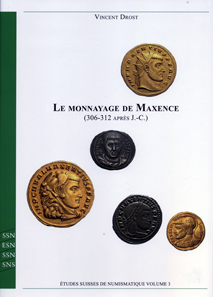by Ursula Kampmann
18th July 2013 – In the series “Etudes Suisses de Numismatiques”, issued by the Swiss Numismatic Society, a new, important work on Roman coins has recently been published. It is a corpus of the coinage of Maxentius with a detailed commentary that exceeds by far that what the RIC can provide.
Let’s start with the catalog that certainly will attract most interest. This is no die corpus – no one would be able to prepare such a thing given the wealth of material from the 3rd century, but a listing of all types and subtypes, i.e. literally everything Maxentius has to offer. Arranged according to mints, dates, metals, Vincent Drost presents the basis of his work, in which he is much more meticulous than the RIC. All collectors who enjoy the different variants of late Roman coinage will find a marvelous overwiew here.
As already said, this is the basis, and the catalog being written in French is no obstacle to its comprehensibility for every single type and subtype is illustrated in the plates. Strictly speaking, it is here where the author’s work truly starts, with the material he makes talk at great length.
Vincent Drost, Le monnayage de Maxence (306-312 après J.-C.). Wetteren 2013. Cloth-bound, thread-stitching. A4. 432 pages with 61 plates. CD-ROM added. ISBN 978-3-033-03991-9. CHF 150; 120 Euros.
Don’t worry if your schoolroom French is a bit rusty. As I said before, the Swiss Numismatic Society has published this book, meaning that the author provides a detailed 17-page summary of his results that was being translated into Italian, English and German. Quite a luxury one would wish for, for the sake of spreading knowledge in other countries as well. Additionally, the 17-page summary most likely gets more readers than the actual text that covers 200 pages.
By reading it you’ll learn that Maxentius possessed five mints that didn’t produce simultaneously, though; Rome was the only mint Maxentius had at his disposal during his entire reign. Drost describes in detail how coinage and minting were organized – and, of course, looking into the French text always pays off when you want to go into details. The author likewise clarifies the metrological basis and hypothesizes about the scale of the production.
The chapter on circulation goes beyond a mere listing of known treasure finds. On the basis of the content of treasure finds, Drost proves the emperor to be isolated both economically and politically. FYI, after Maxentius was being defeated at the Milvian Bridge, a large portion of his coins were collected and brought to the Constantinian mints to be melted down, evidenced by the Treasure of Gruissan that was lost in 313 near the Gallic coast.
Naturally, the author interprets the messages of the coins as well, and, by comparing it with coins of other emperors, proves that Maxentius actively sought alliances. His religious policy, which was overshadowed by Constantine, and his relationship with the city of Rome are magnificently mirrored in the depictions.
The biggest part, in terms of quantity, is taken up by dealing with individual mints and their products. The author patiently deals with series after series, before he gets to Maxentius in imperial coinage.
Unfortunately, the subject of modern counterfeits has received little attention. An overview of all the coins the author, him being the greatest expert on the coins of Maxentius, has excluded from his work would have been appreciated here. Writing this as the reviewer, one is inclined to be happy about that since, otherwise, how else would it be possible to pick holes in such a thorough, masterful and important study?
This book certainly needs no extra advertising. In the months to come, it surely will turn out to be the standard work on the coinage of Maxentius.
Before I forget: the book comes with a gadget, or a ‘bhaltis’, as it is called in Switzerland (it translates as ‘keep it‘). All those who don’t want to carry a heavy catalog with them on coin fairs but own a tablet, can make use of a CD with a PDF file of the catalog which can easily be fed into the tablet. Hence, even on tour no Maxentius collector has to go without identifying his coins. Should I call it a pity that there isn’t (yet) an interactive column one can mark with a cross?
If you would like to order the new catalog you may do so by writing an email to distributor Paul-Francis Jacquier.





